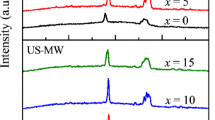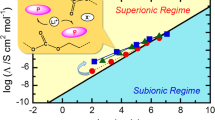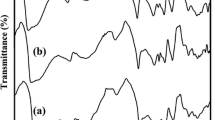Abstract
Plasticized polymer electrolytes comprising of ethylene carbonate as the plasticizing agent in poly (vinyl chloride) [PVC]–poly (butyl methacrylate) [PBMA] blended polymer electrolytes were prepared by solution casting technique. Complex formation, structural elucidation, conductivity, dielectric parameters (Ɛ′, Ɛ″, M′, and M″), thermal stability, and surface morphology are brought out from FTIR, XRD, ac impedance analysis, dielectric studies, thermogravimetry/differential thermal analysis, and scanning electron microscopic studies, respectively. Polymer electrolytes are found to exhibit higher ionic conductivity at higher concentration of plasticizer at the cost of their mechanical stability. Conductivity of 1.879 × 10−4 S cm−1 is exhibited by the polymer electrolyte consisting of 69% of plasticizer with appreciable thermal stability up to 523 K. Temperature and frequency dependence of conductivity is found to follow Vogel Tammann Fulcher relation and Jonscher power law, respectively. Real and imaginary parts of dielectric constants are found to decrease with increase in frequency which could be due to the electrode polarization effect.








Similar content being viewed by others
Reference
Zhu YS, Wang XJ, Hou YY, Gao XW, Liu LL, Wu YP, Shimizu M (2013) A new single-ion polymer electrolyte based on polyvinyl alcohol for lithium ion batteries. Electrochim Acta 87:113
Sekhon S (2003) Effect of donor number of solvent on the conductivity behaviour of nonaqueous proton-conducting polymer gel electrolytes. Solid State Ionics 160:301
Murata K, Izuchi S, Yoshihisa Y (2000) An overview of the research and development of solid polymer electrolyte batteries. Electrochim Acta 45:1501
Radha KP, Selvasekarapandian S, Karthikeyan S, Hema M, Sanjeeviraja C (2013) Synthesis and impedance analysis of proton-conducting polymer electrolyte PVA: NH4F. Ionics 19:1437
Ji J, Li B, Zhong W-H (2010) Effects of a block copolymer as multifunctional fillers on ionic conductivity, mechanical properties, and dimensional stability of solid polymer electrolytes. J Phys Chem B 114:13637
Ramesh S, Winie T, Arof AK (2007) Investigation of mechanical properties of poly (vinyl chloride)–polyethylene oxide (PVC–PEO) based polymer electrolytes for lithium polymer cells. Eur Polym J 43:1963
Ulaganathan M, Rajendran S (2011) Novel Li-ion conduction on poly (vinyl acetate)-based hybrid polymer electrolytes with double plasticizers. J Appl Electrochem 41:83
Rajendran S, Babu R, Sivakumar P (2008) Ionic conduction in plasticized PVC/PAN blend polymer electrolytes. Ionics 14:149
Ji J, Li B, Zhong WH (2010) Simultaneously enhancing ionic conductivity and mechanical properties of solid polymer electrolytes via a copolymer multi-functional filler. Electrochim Acta 55:9075
Prasanth R, Shubha N, Hng HH, Srinivasan M (2014) Effect of poly (ethylene oxide) on ionic conductivity and electrochemical properties of poly (vinylidenefluoride) based polymer gel electrolytes prepared by electrospinning for lithium ion batteries. J Power Sources 245:283
Sim LN, Majid SR, Arof AK (2014) Effects of 1–butyl–3–methyl imidazolium trifluoromethanesulfonate ionic liquid in poly (ethyl methacrylate)/poly (vinylidenefluoride–co–hexafluoropropylene) blend based polymer electrolyte system. Electrochim Acta 123:190
Stepniak I (2014) Compatibility of poly (bisAEA4)-LiTFSI–MPPipTFSI ionic liquid gel polymer electrolyte with Li4Ti5O12 lithium ion battery anode. J Power Sources 247:112
Pan CY, Gao JH, Zhang Q, Feng Q, Chao M (2008) Preparation and properties of PEO/LiClO4/KH560-SiO2 composite polymer electrolyte by sol-gel composite-in-situ method. J Cent S Univ Technol 15:295
Liang B, Tang S, Jiang Q, Chen C, Chen X, Li S, Yan X (2015) Preparation and characterization of PEO-PMMA polymer composite electrolytes doped with nano-Al2O3. Electrochim Acta 169:334
Morenoa M, Quijada R, Santa Anaa MA, Benaventea E, Gomez-Romero P, González G (2011) Electrical and mechanical properties of poly(ethylene oxide)/intercalated clay polymer electrolyte. Electrochim Acta 58:112
Ramesh S, Yi J (2009) Structural, thermal, and conductivity studies of high molecular weight poly (vinylchloride)-lithium triflate polymer electrolyte plasticized by dibutyl phthalate. Ionics 15:725
Flora XH, Ulaganathan M, Rajendran S (2013) Role of different plasticizers in li-ion conducting poly (acrylonitrile)-poly (methyl methacrylate) hybrid polymer electrolyte. Int J Polym Mater Polym Biomater 62:737
Das S, Ghosh A (2015) Effect of plasticizers on ionic conductivity and dielectric relaxation of PEO-LiClO4 polymer electrolyte. Electrochim Acta 171:59
Kumar M, Sekhon SS (2002) Role of plasticizer’s dielectric constant on conductivity modification of PEO–NH4F polymer electrolytes. Eur Polym J 38:1297
Agrawal RC, Pandey GP (2008) Solid polymer electrolytes: materials and designing and all-solid-state battery applications: an overview. J Phys D Appl Phys 41:223001
Felix BD, Lambertus P, Jakobert BJV (2000) Trends in polymer electrolytes for secondary lithium batteries. J Power Sources 88:169
Zhou D, Fan LZ, Fan H, Shi Q (2013) Electrochemical performance of trimethylolpropane trimethylacrylate-based gel polymer electrolyte prepared by in situ thermal polymerization. Electrochim Acta 89:334
Choi J-W, Cheruvally G, Kim Y-H, Kim J-K, Manuel J, Raghavan P, Ahn J-H, Kim K-W, Ahn H-J, Choi DS, Song CE (2007) Poly(ethylene oxide)-based polymer electrolyte incorporating room-temperature ionic liquid for lithium batteries. Solid State Ionics 178:1235
Zhang H, Xuan X, Wang J, Wang H (2005) Effect of poly(vinylidene fluoride) on solvation of NaSCN in PEO. Spectrochim Acta A 61:347
Rajendran S, Sivakumar M, Subadevi R (2003) Effect of plasticizers in poly (vinyl alcohol)-based hybrid solid polymer electrolytes. J Appl Polym Sci 90:2794
Woo HJ, Majid SR, Arof AK (2013) Effect of ethylene carbonate on proton conducting polymer electrolyte based on poly (ε-caprolactone) (PCL). Solid State Ionics 252:102
Hwang JJ, Liu HJ (2002) Influence of organophilic clay on the morphology, plasticizer-maintaining ability, dimensional stability, and electrochemical properties of gel polyacrylonitrile (PAN) nanocomposite electrolytes. Macromolecules 35:7314
Isa KM, Osman Z, Arof AK, Othman L, Zainol NH, Samin SM, Chong WG, Kamarulzaman N (2014) Lithium ion conduction and ion–polymer interaction in PVdF-HFP based gel polymer electrolytes. Solid State Ionics 268:288
Vikas Mittal. Functional polymer blends, London New York. 2012.
Morita M, Tanaka H, Ishikawa M, Matsuda Y (1996) Effects of crown ethers on the electrochemical properties of polymeric solid electrolytes consisting of poly (ethylene oxide)-grafted poly (methylmethacrylates). Solid State Ionics 86-88:401
Wen Z, Itoh T, Ichikawa Y, Kubo M, Yamamoto O (2000) Blend-based polymer electrolytes of poly (ethylene oxide) and hyperbranched poly [bis (triethylene glycol) benzoate] with terminal acetyl groups. Solid State Ionics 134:281
Rajendran S, Babu RS (2009) Ionic conduction behavior in PVC–PEG blend polymer electrolytes upon the addition of TiO2. Ionics 15:61
R. J. Sengwa, S. Choudhary, Dielectric properties and fluctuating relaxation processes of poly (methyl methacrylate) based polymeric nanocomposite electrolytes, J Phys Chem Solids 75 (2014) 765.
Nithya H, Selvasekarapandian S, Arun Kumar D, Sakunthala A, Hema M, Christopherselvin P, Kawamura J, Baskaran R, Sanjeeviraja C (2011) Thermal and dielectric studies of polymer electrolyte based on P(ECH-EO). Mater Chem Phys 126:404–408
Pradhan DK, Samantary BK, Choudhary RNP, Thakur AK (2005) Effect of plasticizer on microstructure and electrical properties of a sodium ion conducting composite polymer electrolytes. Ionics 11:95–102
Frech R, Chintapalli S (1996) Effect of propylene carbonate as a plasticizer in high molecular weight PEO-LiCF3SO3 electrolytes. Solid State Ionics 85:61
Lin-Vien D, Colthup NB (1991) In: Fateley WG, Grasselli JG (eds) The handbook of infrared and Raman characteristic frequencies of organic molecules, Elsevier
Sim LN, Majid SR, Arof AK (2012) FTIR studies of PEMA/PVdF-HFP blend polymer electrolyte system incorporated with LiCF3SO3 salt. Vib Spectrosc 58:57
Schrader B (1995) Infrared and Raman spectroscopy. VCH Publishers. Inc., New York
Uma T, Mahalingam T, Stimming U (2005) Conductivity studies on poly(methyl methacrylate)–Li2SO4 polymer electrolyte systems. Mater Chem Phys 90:245
Ali AMM, Yahya MZA, Bahron H, Subban RHY, Harun MK, Atan I (2007) Impedance studies on plasticized PMMA-LiX [X: CF3SO3 −, N(CF3SO2)2 −] polymer electrolytes. Mater Lett 61:2026
Ramesh S, Koay HL, Kumutha K, Arof AK (2007) FTIR studies of PVC/PMMA blend based polymer electrolytes. Spectrochim Acta A 66:1237
Jiang J, Gao D, Li Z, Guangyao S (2006) Gel polymer electrolytes prepared by in situ polymerization of vinyl monomers in room-temperature ionic liquids. React Funct Polym 66:1141
Rajendran S, Mahendran O, Kannan R (2002) Characterization [(1-x) PMMA-x PVdF] polymer blend electrolyte with li+ ion. Fuel 81:1077
Achari VB, Reddy TJ, Sharma AK, Rao VN (2007) Electrical, optical, and structural characterization of polymer blend (PVC/PMMA) electrolyte films. Ionics 13:349
Helan Flora X, Ulaganathan M, Babu RS, Rajendran S (2012) Evaluation of lithium ion conduction in PAN/PMMA-based polymer blend electrolytes for li-ion battery applications. Ionics 18:731
Rajendran S, Babu R, Sivakumar P (2009) Optimization of PVC–PAN-based polymer electrolytes. J Appl Polym Sci 113:1651
Ramesh S, Ng HM (2011) An investigation on PAN–PVC–LiTFSI based polymer electrolytes system. Solid State Ionics 192:2
Ostrovskii D, Brodin A, Torell LM, Appetecchi GB, Scrosati B (1998) Molecular and ionic interactions in poly (acrylonitrile)-and poly (methylmetacrylate)-based gel electrolytes. J Chem Phys 109:7618
Stephan AM, Thirunakaran R, Renganathan NG, Sundaram V, Pitchumani S, Muniyandi N, Gangadharan R, Ramamoorthy P (1999) A study on polymer blend electrolyte based on PVC/PMMA with lithium salt. J Power Sources 81:752
Kumar D, Hashmi SA (2010) Ion transport and ion–filler-polymer interaction in poly (methyl methacrylate)-based, sodium ion conducting, gel polymer electrolytes dispersed with silica nanoparticles. J Power Sources 195:5101
Rhoo H-J, Kim H-T, Park J-K, Hwang T-S (1997) Ionic conduction in plasticized PVC/PMMA blend polymer electrolytes. Elecrrochimrca Acta 42(10):1571–1579
Yahya MZ, Arof AK (2003) Effect of oleic acid plasticizer on chitosan–lithium acetate solid polymer electrolytes. Eur Polym J 39:897
Latif F, Aziz M, Ali AM, Yahya MZ (2009) The coagulation impact of 50% epoxidised natural rubber chain in ethylene carbonate-plasticized solid electrolytes. In Macromolecular symposia 277:62–68
Kalogeras IM, Hagg Lobland HE (2012) J Mater Ed 34:69–94
I. M. Kalogeras, Glass-transition phenomena in polymer blends, in Encyclopedia of polymer blends, Volume 3: Structure (Ed.: Α.Ι. Isayev), Chapter 1, pp 1–134, Wiley, 2016. ISBN: 978-3-527-31931-2.
Capiglia C, Saito Y, Yamamoto H, Kageyama H, Mustarelli P (2000) Transport properties and microstructure of gel polymer electrolytes. Electrochim Acta 45:1341
Polu AR, Rhee H-W (2015) Nanocomposite solid polymer electrolytes based on poly(ethyleneoxide)/POSS-PEG (n = 13.3) hybrid nanoparticles for lithium ion batteries. J Ind Eng Chem 31:323
Gogulamurali N, Suthanthiraraj SA, Maruthamuthu P (1992) In: Chowdari BVR, Chandra S, Singh S, Srivastava PC (eds) Solid state ionics: materials and applications. World Scientific, Singapore
Venkateswarlu M, Satyanarayana N (1998) AC conductivity studies of silver based fast ion conducting glassy materials for solid state batteries. Mater Sci Eng B 54:189
Polu AR, Kumar R, Rhee H-W (2015) Magnesium ion conducting solid polymer blend electrolyte based on biodegradable polymers and application in solid-state batteries. Ionics 21:125
Jonscher AK (1977) The universal dielectric response. Nature 267:673
Das A, Thakur AK, Kumar K (2014) Conductivity scaling and near-constant loss behavior in ion conducting polymer blend. Solid State Ionics 268:185
Karmakar A, Ghosh A (2012) Dielectric permittivity and electric modulus of polyethylene oxide (PEO)–LiClO4 composite electrolytes. Curr Appl Phys 12:539
Sengwa RJ, Dhatarwal P, Choudhary S (2015) Effects of plasticizer and nanofiller on the dielectric dispersion and relaxation behaviour of polymer blend based solid polymer electrolytes. Curr Appl Phys 15:135–143
Banerjee S, Kumar A (2010) Dielectric behavior and charge transport in polyaniline nanofiber reinforced PMMA composites. J Phys Chem Solids 71:381
Ng HM, Ramesh S, Ramesh K (2015) Exploration on the P (VP-co-VAc) copolymer based gel polymer electrolytes doped with quaternary ammonium iodide salt for DSSC applications: electrochemical behaviors and photovoltaic performances. Org Electron 22:132
Ramesh S, Arof AK (2001) Ionic conductivity studies of plasticized poly (vinyl chloride) polymer electrolytes. Mater Sci Eng B 85:11
Mishra R, Baskaran N, Ramakrishnan PA, Rao KJ (1998) Lithium ion conduction in extreme polymer in salt regime. Solid State Ionics 112:261
Nithya H, Selvasekarapandian S, Kumar DA, Sakunthala A, Hema M, Christopherselvin P, Kawamura J, Baskaran R, Sanjeeviraja C (2011) Thermal and dielectric studies of polymer electrolyte based on P (ECH-EO). Mater Chem Phys 126:404
Acknowledgements
The authors would like to thank VIT University for providing characterization facility (SEM studies under DST-FIST programme). The authors also thank Central Instrumentation Facility department of Pondicherry University for providing TG/DTA characterizations.
Author information
Authors and Affiliations
Corresponding author
Additional information
Highlights
• Plasticized PVC-PBMA polymer electrolytes are prepared by solution casting technique.
• Temperature- and frequency-dependent ionic conductivity for plasticized PVC-PBMA blend polymer electrolytes follow the VTF relation and Jonscher’s power law respectively.
• Surface morphology of plasticized polymer electrolytes is analyzed using scanning electron microscope analysis.
• Plasticized PVC-PBMA blend polymer electrolytes have good thermal stability up to 523 K.
Rights and permissions
About this article
Cite this article
Arunkumar, R., Babu, R.S., Usha Rani, M. et al. Influence of plasticizer on ionic conductivity of PVC-PBMA polymer electrolytes. Ionics 23, 3097–3109 (2017). https://doi.org/10.1007/s11581-017-2101-2
Received:
Accepted:
Published:
Issue Date:
DOI: https://doi.org/10.1007/s11581-017-2101-2




